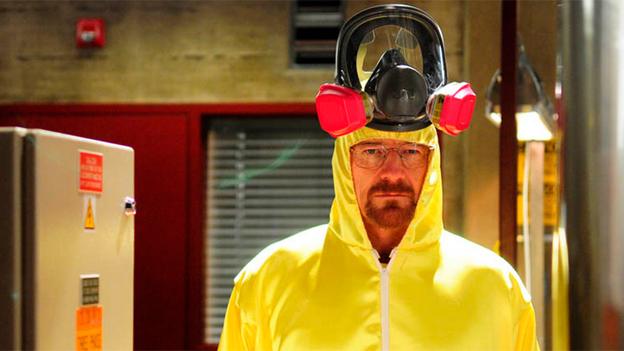Game of Thrones: Finding fact within the fantasy
- Published

Game of Thrones' potent mix of magic, political intrigue and gripping plotlines has made it a TV phenomenon. But are there any real-world parallels to be found in the mythical land of Westeros?
Spoiler warning: Multiple plot details revealed below
With its fire-breathing dragons and zombie-like "white walkers", the show is clearly set in the world of fantasy. However, while comparisons to tales such as Lord of the Rings are obvious, author George RR Martin draws equally on historical influences with the feel of the show rooted in the Middle Ages.
But do any of the spectacular set-pieces and plot devices have equivalents in reality?
Writer, comedian and science enthusiast Helen Keen argues the ties are as strong as a sword forged from Valyrian steel.
Ms Keen, who has written and starred in three series of It Is Rocket Science on BBC Radio 4, has teamed up with Ian Simmons, science communication director at Newcastle's Life centre, for a show examining the similarities.

Real life dragons?
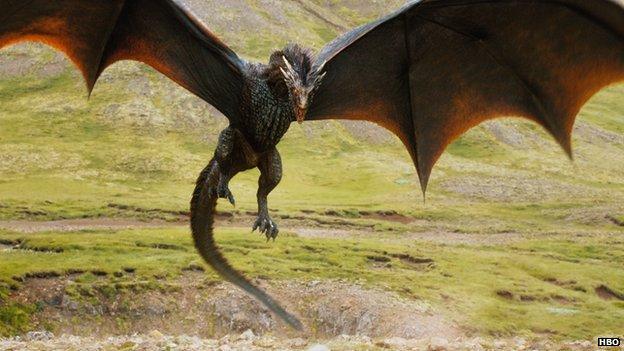
Game of Thrones' terrifying dragons are beasts of war
Kingdoms and lands across Westeros have been conquered with the help of the fearsome, fire-breathing beasts, but are we ever likely to see real-world equivalents?
We already have, Ms Keen argues, in the form of the Quetzalcoatlus., external
One of the largest known flying animals in history with a wingspan thought to be about 11m (36ft), they took to the skies about 68 million years ago.
Archaeologists discovered the first fossils in Texas in 1971.
"I don't think they would look particularly similar," Ms Keen admits. "The dragons from the show never stop growing, no matter how old they are."
As for the fire-breathing, there is a creature that could be seen to fit the bill - although on a much less epic scale than the TV series' monstrous foes.
Its name? The bombardier beetle, which emits a hot, noxious fluid (a mix of hydroquinone and hydrogen peroxide) from its rear end when defending itself from attack or confronting prey.
"It's quite a curious little creature," says Ms Keen. "It has all these things in its body which it can mix together and then squirt out as an explosive type of substance at its enemy."
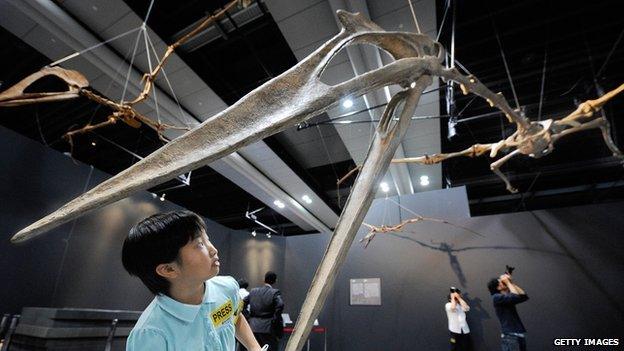
A replica Quetzalcoatlus skeleton was displayed in Tokyo in 2008

What is Game of Thrones?
Based on a series of books by George RR Martin called A Song of Ice and Fire, the show follows the struggles of noble families fighting to control the land of Westeros
Drawing on historical events such as 15th Century England's Wars of the Roses, fantasy elements sit side-by-side with a firm medieval feel and the mix has proved compulsive viewing for fans across the globe
With a sprawling list of characters and show-stopping set-pieces, its budget is among the biggest on TV with one episode alone, Blackwater, reportedly costing $8m (£5.4m)
The closing episode of season four in the US drew an audience of 7.1 million, a record for cable channel HBO
The world premiere of season five was recently staged at the Tower of London

Could Tyrion have burnt the fleet at Blackwater Bay?
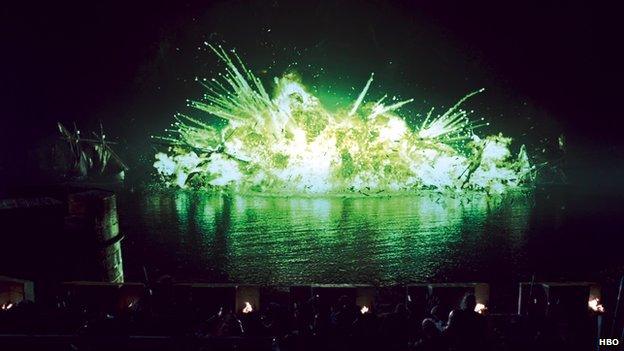
Stannis Baratheon's fleet is routed by the explosive power of wildfire
As season two hurtles towards its climax, the marauding forces of Stannis Baratheon set sail for King's Landing and the spectacular Battle of Blackwater Bay ensues.
To the bemusement of King Joffrey, his uncle Tyrion Lannister sends a solitary, unmanned, ship in defence.
His plan soon becomes clear, though, as archer Bronn's arrow ignites the "wildfire" leaking into the water and fierce explosions light up the night sky.
"Wildfire is conjured up by Westeros's alchemists and there are parallels between that and the horrible use of napalm," says Ms Keen.
"It burns and carries on burning even if you put it on water and it has horrific effects on fellow human beings. It's an interesting echo."
A mixture of gasoline, benzene and a thickening agent, it was invented at Harvard University in the 1940s for use in flame throwers and other weapons.
Its deployment by American forces during the Vietnam War two decades later provided a number of unforgettably stark images.
Perhaps less well known is Project X-ray, which would have seen a huge number of bats, external strapped with small capsules of explosive being flown to Japan during World War 2.
The plan was that after the bats took shelter in buildings, the capsules would detonate. However, the plan went up in flames, literally, when an air force base in New Mexico was destroyed during testing.
"It was an imaginative, if very weird, idea," says Ms Keen.
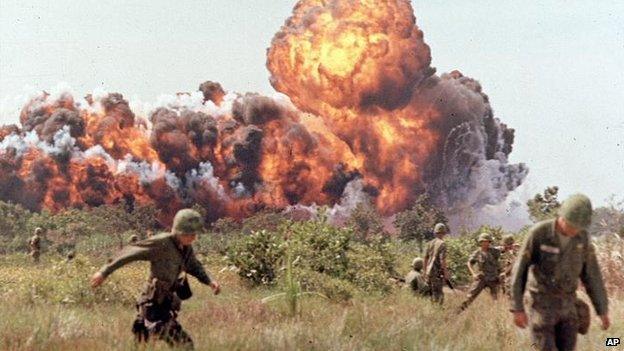
Napalm was infamously used by American forces to devastating effect during the Vietnam War

Are there poisons that would kill Joffrey so quickly?
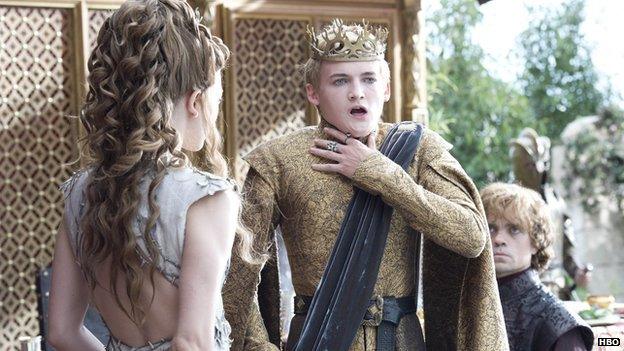
Within seconds of drinking from the poisoned chalice, Joffrey is quickly overcome
Despite deserting during the Battle of Blackwater Bay, the cowardly King Joffrey is quick to claim the credit for masterminding the Lannister victory.
His comeuppance finally arrives during season four when, while celebrating his marriage to Margaery Tyrell, a poison known as The Strangler is slipped in to his glass of wine. He dies in his mother's arms.
Many of the symptoms are similar to those brought on by cyanide, Mr Simmons says.
"It is quickly absorbed from the gut, causes burning in the throat and can also lead to a fluid build-up in the lungs. As well as vomiting and confusion, it could trigger Joffrey's coughing fit.
"It inhibits an enzyme called cytochrome oxidase, which plays a key role in the body's system for generating energy.
"When that system is halted, gasp as he might, a person's cells can no longer access life-giving oxygen. As death nears, the person's skin can turn blue. It's a clinical effect called cyanosis."
But the symptoms do not match perfectly, as "dramatic bleeding is not typical". So what else could prove similarly fatal in the real world?
"Deadly nightshade - a favourite poison in medieval times - is another potential strangler," he explains.
"The leaves, stems and berries contain tropane alkaloids, which are extremely potent toxins that disrupt nervous system functioning.
"The victim will begin to stagger, convulse, lose his vision and experience an extremely dry mouth and throat, creating a sensation of choking.
"Blood vessels also dilate, causing the victim to become very hot and turn red. Like cyanide, however, bleeding is not a normal symptom of deadly nightshade, and neither is the speed by which Joffrey succumbed to his fatal dose."

Could The Mountain crush Oberyn's skull?
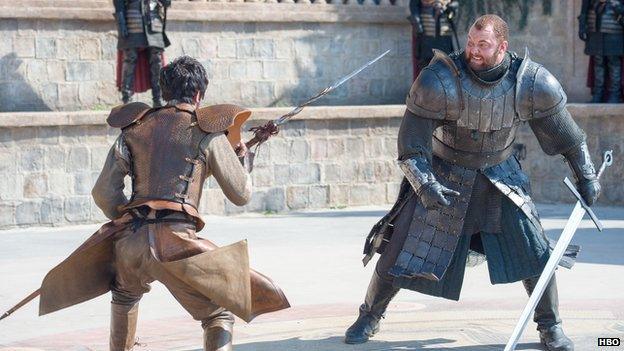
The Mountain, right, looked set to be defeated by Prince Oberyn Martell, but a shock lay in store for viewers
The blame for Joffrey's death is directed at Tyrion who, in episode eight of season four, faces trial by combat against a warrior known as The Mountain.
The dwarf is represented in battle by Prince Oberyn Martell, who seeks vengeance on The Mountain for the rape and murder of his sister and the death of her children.
Prince Oberyn fells the armour-clad giant, but determined to force his opponent to confess to acting on the orders of Tywin Lannister, delays landing a fatal blow.
It proves costly, as The Mountain upends him with an outstretched hand and proceeds to kill him by crushing his skull.
But could a real person exert such brute force?
"George RR Martin describes The Mountain as nearly 8ft tall (2.4m) and weighing about 420lbs (190kg) of solid muscle," says Mr Simmons.
"Research into safety helmets has found that to fracture the skull would require 500kg (1,100lbs) of force.
"A man would have to weigh 500kg to do that by stepping on the head, so it would be impossible to break someone's skull with your bare hands even if 90% of the 500kg were biceps muscles."

Valyrian steel - is any steel so strong and sharp?
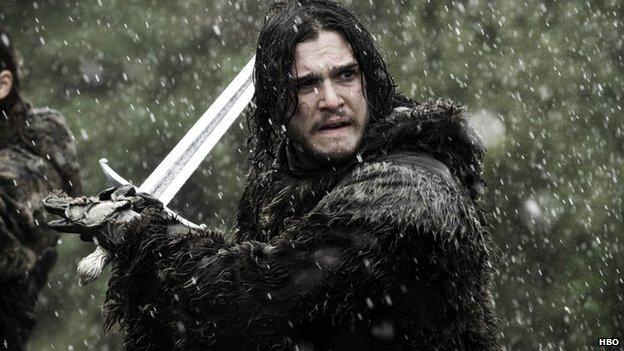
Heroic Jon Snow's Longclaw sword has a clear rippled pattern, which is a characteristic of Valyrian steel
With few left in existence, Game of Thrones' most-treasured hand-held weapons are the swords forged from Valyrian steel - a precious alloy characterised by its incredible sharpness and strength but which remains light enough to be wielded with ease by skilled fighters.
Passed down to the descendents of the noble houses, the blades are identifiable by a rippled pattern which shows the steel has been folded over thousands of times.
In a world where every day could be your last, the value of such a weapon is clear, but is that kind of powerful steel the preserve of fantasy? Not according to Mr Simmons.
"The description of Valyrian steel is similar to that of Damascus steel, a form of steel once made in the Middle East but whose formula is now lost.
"It's also like the steel Japanese katana swords are made from. Both use wootz, a form of steel exported from India, as their basis.
"A high carbon content is thought to be important and legend has it that true Damascus swords were tempered by being plunged hot into the body of prisoners.
"In Game of Thrones, Tywin Lannister melts down and recasts Eddard Stark's Valyrian steel sword, Ice, to create two swords. This would not work with Damascus steel as the characteristics that make it special are destroyed by melting."
The Science of Game of Thrones will be at Newcastle's Life on 2 April, Edinburgh's Summerhall on 10 April and London's Royal Institution on 22 April.
- Published10 February 2015

- Published28 December 2014

- Published4 April 2014

- Published16 August 2013
